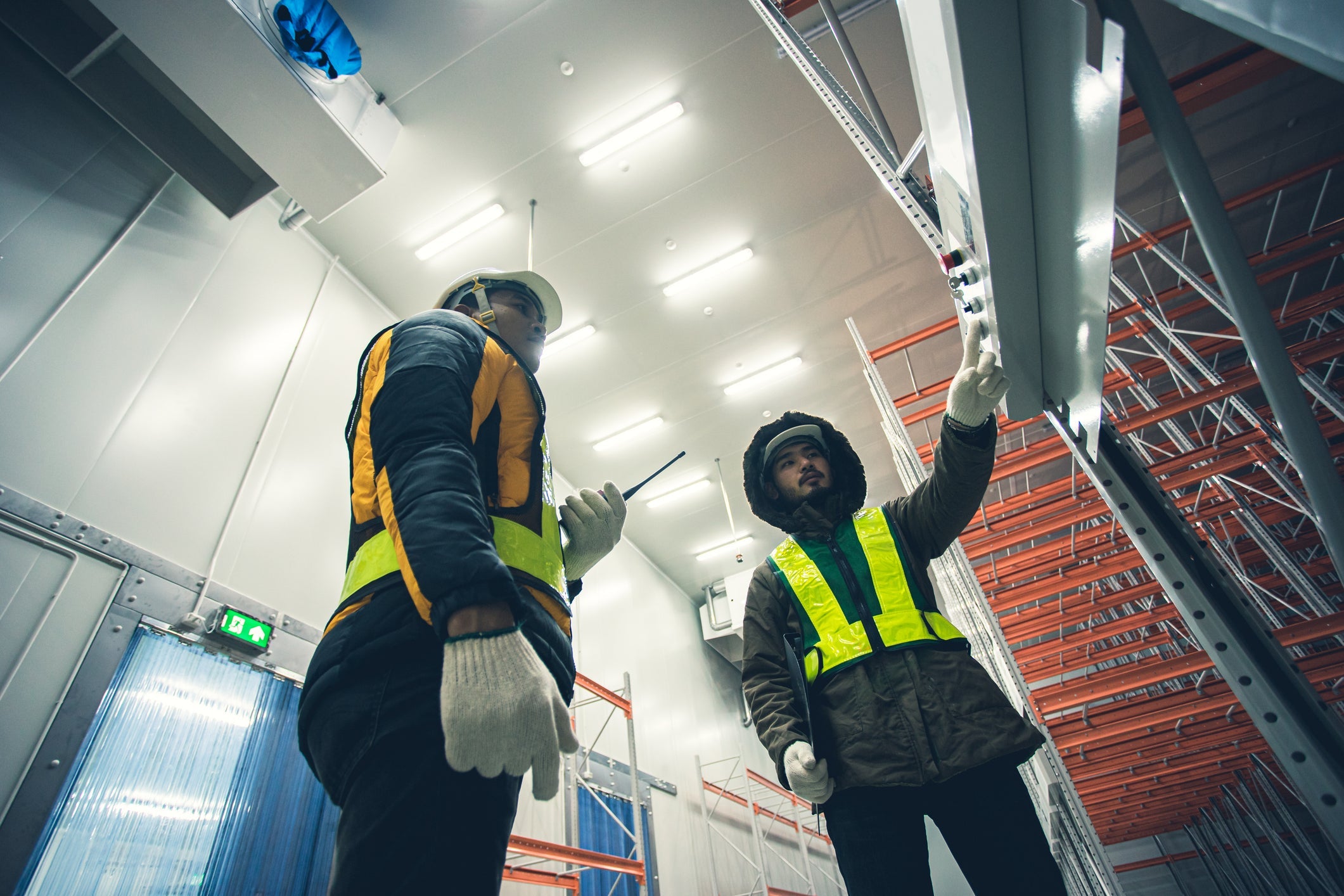Quick Summary: Commercial freezers and cold storage facilities are vital to food, pharmaceutical, and logistics industries — but working in freezing environments poses unique safety challenges. From frostbite to slips, workers face daily risks that can be prevented with the right personal protective equipment (PPE). Here’s what every facility manager needs to know about freezer safety and OSHA compliance in 2025.
Understanding the Hazards of Cold Work Environments
Working in subzero temperatures creates immediate and long-term health risks. Even short exposure to cold can lead to reduced dexterity, loss of grip, and slower reaction times — all of which increase accident potential. Extended exposure can result in frostbite, trench foot, or hypothermia. The Occupational Safety and Health Administration (OSHA) classifies these risks under 29 CFR 1910.132 and 1910.138, requiring employers to provide protective clothing and PPE against environmental hazards.
Beyond the human risks, cold environments can also affect machinery, lighting, and emergency response times. Freezer rooms with tight spaces and slick flooring demand additional attention to training and equipment.
Common Hazards in Commercial Freezers
- Frostbite: Skin tissue damage caused by prolonged exposure to cold, often affecting hands, ears, and face.
- Hypothermia: A dangerous drop in body temperature that impairs movement and decision-making.
- Slips and Falls: Ice buildup and condensation make freezer floors slippery and dangerous.
- Equipment Malfunction: Cold temperatures can weaken materials and cause machinery failure.
- Limited Visibility: Fog and lighting issues make it harder to identify hazards quickly.
Required PPE for Commercial Freezer Work
Workers in walk-in freezers, cold storage warehouses, or refrigerated trucks need PPE specifically rated for cold environments. The right gear not only prevents injuries but also keeps productivity high in extreme conditions.
1. Thermal and Insulated Gloves
Hands are the most vulnerable body part in cold work. Choose gloves that balance insulation with dexterity.
- Thermal Work Gloves – Keep hands warm while maintaining grip for loading and stacking tasks.
- Cut-Resistant Cold Gloves – Ideal for meat processing or packaging areas with sharp tools.
2. Insulated Footwear
Cold, wet floors are a leading cause of slips and frostbite. Use footwear with slip-resistant soles and thermal lining.
- Insulated Safety Boots – Waterproof, non-slip, and rated for below-freezing temperatures.
- Ice Cleats and Traction Devices – Improve stability on icy or wet floors.
3. Cold-Rated Head and Face Protection
Protect exposed skin from wind chill and frostbite with thermal headgear.
- Freezer Face Shields – Prevent frost accumulation and protect against sudden temperature shifts.
- Thermal Liners and Balaclavas – Designed to fit under hard hats and helmets.
4. Insulated Jackets and Coveralls
Layering is critical. Freezer-rated clothing provides insulation while allowing mobility.
- Freezer Jackets and Parkas – Water-resistant and windproof with heavy-duty zippers and adjustable cuffs.
- Thermal Coveralls – Full-body insulation for extended cold exposure.
5. High-Visibility Apparel
Cold storage environments often have low light and moving forklifts. High-visibility gear prevents accidents in dimly lit conditions.
- High-Visibility Vests – Reflective materials ensure workers remain visible even through fog and condensation.
Best Practices for Freezer Safety
- Limit exposure time: Schedule breaks in warm areas and rotate staff to prevent overexposure.
- Use anti-slip mats: Place them in high-traffic zones to reduce fall risk.
- Monitor temperature and humidity: Use temperature detectors to identify unsafe conditions early.
- Emergency planning: Train staff on lock-in prevention, exit routes, and first-aid procedures.
- Proper lighting: Use LED lighting suitable for cold storage to enhance visibility and reduce fogging.
OSHA and ANSI Standards
Under OSHA 1910.132 (general PPE requirements) and 1910.138 (hand protection), employers must assess and provide protection suitable for cold exposure. ANSI/ISEA 201 Standard also covers performance specifications for cold-weather gloves and apparel. Documentation of PPE issuance, employee training, and inspection cycles are mandatory for compliance.
Emergency PPE and First Aid
In addition to cold-protection PPE, maintain an emergency kit near freezer entries. Include thermal blankets, first-aid supplies, and hand warmers. Workers showing early signs of frostbite — numbness, pale skin, or stiffness — should immediately move to a warm area and report to a supervisor.
Conclusion
Commercial freezer environments demand constant vigilance and proper PPE to keep workers safe from cold stress, slips, and equipment-related injuries. With insulated gear, high-visibility apparel, and clear safety protocols, facilities can meet OSHA standards while protecting their most valuable resource — their people.
Shop freezer-rated PPE at eSafetySupplies.com for OSHA-compliant gloves, jackets, boots, and insulated coveralls designed to perform in extreme cold.
People Also Ask
What temperature is considered hazardous in commercial freezers?
Any work below 32°F (0°C) can pose risk, while environments under -20°F (-29°C) require specialized cold-weather PPE and limited exposure time.
What PPE is required for working in freezers?
Thermal gloves, insulated boots, freezer jackets, high-visibility apparel, and head/face protection are essential for safety and OSHA compliance.
How often should PPE be inspected in cold environments?
Inspect PPE before each use for moisture buildup, cracks, or tears. Replace any gear showing stiffness or loss of insulation performance.
What are signs of frostbite or hypothermia in workers?
Watch for pale skin, numbness, slow speech, or shivering. Workers should warm up immediately and seek medical attention if symptoms persist.
Where can I buy freezer PPE for warehouse workers?
OSHA-approved freezer jackets, gloves, and insulated boots are available at eSafetySupplies.com.
About the Author
Mick Chan is a Safety Supplies industry professional with over 15 years of hands-on experience. He specializes in OSHA compliance, PPE regulations, and bulk safety product procurement for high-risk industries. Mick earned his Bachelor’s degree in Business Administration from Cal State LA in 2013 and has been advising companies across California ever since. Born and raised in the San Gabriel Valley, Mick understands the safety needs of businesses in diverse urban and industrial environments. His work focuses on bridging safety compliance with practical product solutions for the modern workplace.

